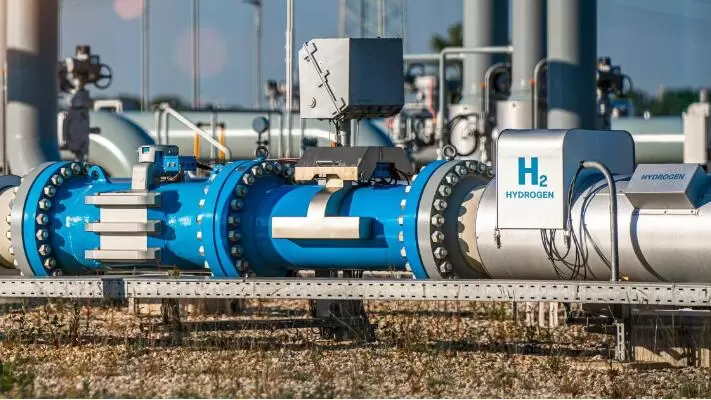Blue hydrogen occupies a unique position in the cost spectrum of hydrogen production. While more expensive than grey hydrogen due to the addition of CCS/CCUS technologies, it currently stands as a more economically viable option than green hydrogen in many contexts. This analysis dives into the financial nuances, including the impact of technological advancements and economies of scale.
The market for blue hydrogen is growing, driven by increasing demand for cleaner energy sources and supportive government policies. This section examines the factors influencing the supply, demand, and pricing of blue hydrogen, along with its competitive positioning in the energy market.
Significant investments are being made in the blue hydrogen sector, from research and development to large-scale production facilities. This part explores the sources of funding, highlighting key investments and the role of public-private partnerships in advancing the blue hydrogen economy.

Blue hydrogen has the potential to decarbonize industrial processes that are currently reliant on fossil fuels. This segment covers its use in industries such as steelmaking, chemical production, and refining, illustrating the tangible benefits of blue hydrogen in reducing industrial carbon emissions.
Beyond industrial applications, blue hydrogen can play a crucial role in energy generation and storage, offering a flexible and low-carbon solution for power grids. The potential of blue hydrogen to support renewable energy sources and provide grid stability is examined here.
Transportation is another key area where blue hydrogen can make a significant impact. This section discusses its use in fuel cell vehicles, from passenger cars to heavy-duty trucks and buses, highlighting the challenges and opportunities in building the infrastructure for hydrogen fueling stations.
Certain countries are leading the way in blue hydrogen production, driven by robust policies, technological capabilities, and natural resources. This part identifies the frontrunners in the blue hydrogen space, detailing their strategies and contributions to the global hydrogen economy.
The development of the blue hydrogen industry is increasingly characterized by international collaborations and cross-border projects. By exploring key global initiatives, this segment sheds light on how countries and companies are working together to scale up blue hydrogen production and use.
Government policies and regulatory frameworks significantly impact the growth of the blue hydrogen sector. This section reviews the current policy landscape, including incentives, standards, and regulations that are shaping the production, distribution, and utilization of blue hydrogen.
As the linchpin of blue hydrogen production, the future of CCS and CCUS technologies holds great promise. This part forecasts the technological advancements on the horizon, discussing their potential to enhance efficiency, reduce costs, and increase the scalability of blue hydrogen production.
While advancements in carbon capture technology are encouraging, there are inherent limitations and challenges that must be addressed. This section critically assesses the potential of CCS and CCUS to meet the growing demand for blue hydrogen and its role in achieving long-term sustainability goals.
Innovation in CCS and CCUS technology is crucial for the successful scale-up of blue hydrogen. This part explores the avenues for innovation, from research and development efforts to the implementation of pilot projects and commercial-scale operations.

Despite its advantages over grey hydrogen, blue hydrogen has faced criticism for still relying on fossil fuels. This segment delves into the environmental concerns associated with blue hydrogen production, including the efficiency of carbon capture and the lifecycle emissions of hydrogen use.
The economic viability of blue hydrogen, particularly in comparison to rapidly advancing green hydrogen technologies, is a topic of debate. Here, the economic challenges, including the cost of CCS/CCUS technologies and the impact of fluctuating fossil fuel prices, are examined.
Technical challenges in carbon capture efficiency, hydrogen storage, and transport are significant barriers to the widespread adoption of blue hydrogen. This section discusses the ongoing efforts and innovations aimed at overcoming these obstacles.
Blue hydrogen is often viewed as a transitional fuel that can pave the way for a greener hydrogen economy. This part considers how blue hydrogen can act as a stepping stone, providing a cleaner alternative while green hydrogen technologies mature and become more economically viable.
In the transition to a low-carbon energy system, blue hydrogen can play a critical role. This section explores its position within the broader energy mix, highlighting how it complements other forms of renewable energy and contributes to energy security and diversity.
For blue hydrogen to effectively serve as a transitional fuel, strategic planning and implementation are key. This segment outlines the strategies needed to maximize the benefits of blue hydrogen in the short term while laying the groundwork for a sustainable energy future.
Public perception of blue hydrogen varies, influenced by awareness of its environmental benefits and concerns over its reliance on fossil fuels. This part discusses the importance of education and transparency in building public support for blue hydrogen projects.
Government policy plays a decisive role in the adoption of blue hydrogen, from subsidies and incentives to regulatory standards. By examining the impact of policy on the development of the blue hydrogen market, this section highlights the critical factors that can accelerate or impede its growth.
As the world seeks sustainable energy solutions, blue hydrogen can contribute to this transition. This part considers how policies and public engagement can encourage the adoption of sustainable energy practices, including the use of blue hydrogen alongside other renewable resources.
Blue hydrogen represents a significant advancement in efforts to decarbonize the energy sector. This conclusion reflects on the role of blue hydrogen in the transition to cleaner energy solutions, balancing the need for immediate carbon reduction with the pursuit of ultimate sustainability.
By leveraging existing infrastructure and technological innovations, blue hydrogen combines traditional energy practices with cutting-edge advancements. This section celebrates the synergy between tradition and innovation, underscoring the importance of blue hydrogen in the evolving energy landscape.
Highlighting successful blue hydrogen initiatives and projects around the world can serve as inspiration and a roadmap for future endeavors. This part showcases examples of how blue hydrogen is being implemented globally, demonstrating its potential and the collaborative efforts driving its expansion.
What is blue hydrogen, and how is it produced?
How does blue hydrogen reduce environmental impact compared to grey hydrogen?
What are the main applications of blue hydrogen?
What challenges does blue hydrogen face in terms of scalability and cost?
How can blue hydrogen contribute to the global energy transition?
What role do CCS and CCUS technologies play in the production of blue hydrogen?
Embracing Blue Hydrogen's Role in a Sustainable Future
The journey of blue hydrogen, from concept to an integral component of the global energy mix, showcases its potential as a bridge towards a more sustainable and low-carbon energy future. While it leverages the existing natural gas infrastructure and technological advancements in carbon capture, blue hydrogen also paves the way for the eventual dominance of green hydrogen and other renewable energy sources. By addressing the immediate need for significant CO2 emission reductions, blue hydrogen acts as a pragmatic step forward in the energy transition.

Submit your demand,
we will contact you ASAP.

Sanxin New Materials Co., Ltd. focus on producing and selling ceramic beads and parts such as grinding media, blasting beads, bearing ball, structure part, ceramic wear-resistant liners, Nanoparticles Nano Powder

